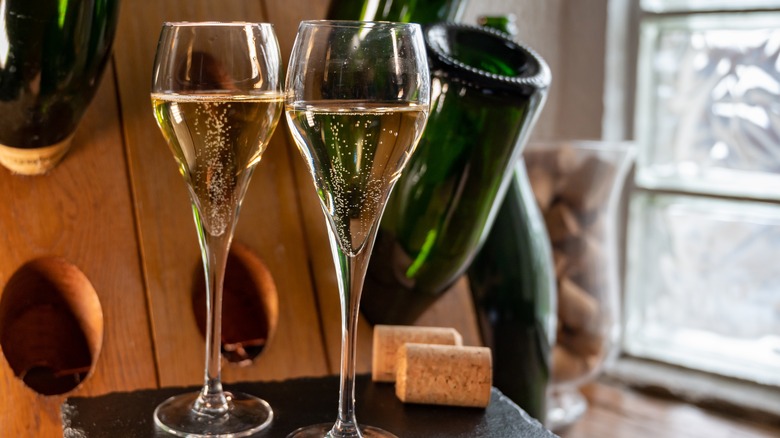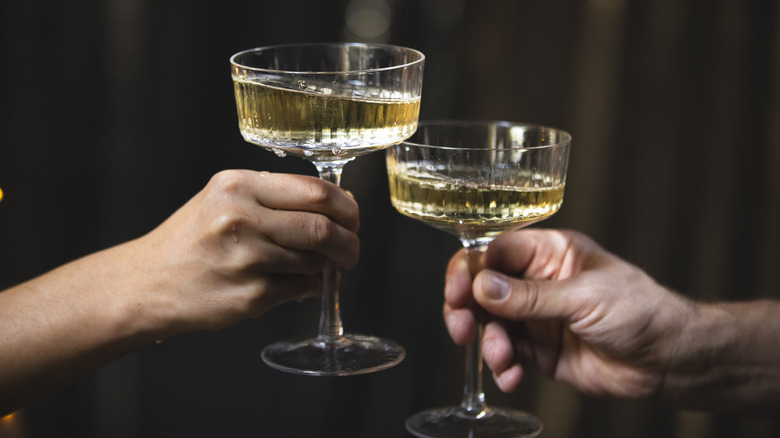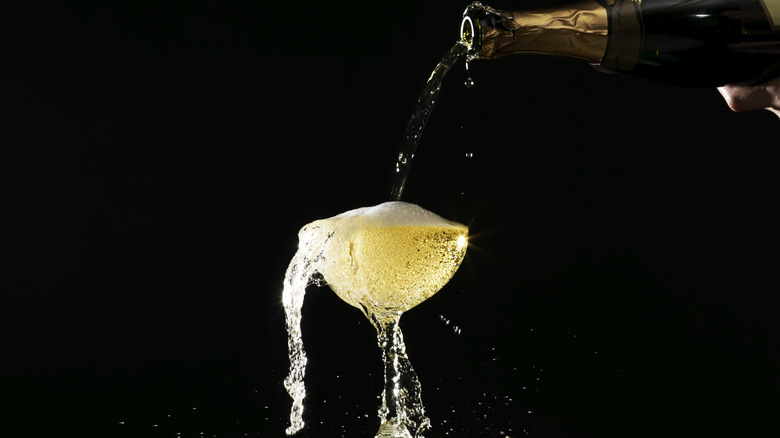The Key Difference Between Cava And Champagne
While we can all agree that any celebration is made better by a bottle of bubbly, not everyone knows that there are big differences between some sparkling wines — such as Cava — and Champagne. We may use "Champagne" as a generic term for any sparkling white wine served at New Year's and other parties, but it's actually a very specific product that needs to adhere to certain standards to carry the name. The same goes for Cava, a cheaper but still popular alternative.
The most major, key difference between Champagne and Cava is the grapes that are used to make each wine. Of course, there are many other factors at work in creating their signature flavors and other traits, but grapes are the heart of the matter. To deepen our understanding and appreciation for these fabulous beverages, learning their distinguishing characteristics — and similarities — is essential.
Points of difference and similarity
Sparkling wines go through two separate fermentation processes. The first fermentation step converts the grapes' sugars into alcohol, a process that all wines undergo, while the second fermentation creates the bubbles characteristic of sparkling wines. While they may share similar production steps, many differences distinguish Cava from Champagne.
Champagne is generally more acidic than Cava, with a subtle yeasty flavor and notes of citrus and apple. It's made from a blend of Pinot Noir, Pinot Meunier, and Chardonnay grapes, and fermented using greater pressure than Cava, giving it more persistent and finer bubbles. Most importantly, it's a prized French product that must be produced in the region of Champagne in order to be authentic. Since the establishment of the Madrid System in 1891, no wine produced outside this region, regardless of similarities in production or flavor, can be labeled as true Champagne.
Cava, on the other hand, is a Spanish wine made from a combination of Xarello, Parellada, and Macabeo grapes. It has less sweetness and acidity than Champagne and is typically thought of as a more dry wine. Cava has more of a mineral flavor with notes of citrus, pear, and quince. While the bubbles in Cava are similar to Champagne bubbles, they're slightly less fine. As for the history of the Cava name, when Spain acceded to the European Union in 1986, the Cava region was established, and Cava wine received Designation of Origin (D.O.) status, making it a protected regional product.
The fame of Champagne versus Cava
The umbrella under which Cava, Champagne, and over 15 other wines fall is officially called "sparkling wine." The reason many of us refer to most of these wines as "Champagne" is due to the wine's fame as the ultimate celebratory drink — after all, if you're throwing a party, there's little point in asking guests, "Should we open the Cava?" when "Champagne" is a much more well-known (and fancy-sounding) term.
The connection between Champagne and celebration is an old one. France's King Clovis is said to have been the first person to pop champagne bottles in festivity, meaning the tradition stretches back to the 5th century. The drink became popular among members of the French aristocracy, and has persisted in the Western collective imagination as a drink that symbolizes festivity, opulence, and wealth. Like Kleenex, Q-tips, and countless other brand names commonly used in place of generic terms, "Champagne" has become synonymous with "sparkling wine" — and is even listed as a synonym for sparkling wine on Thesaurus.com.
Even though Cava has historically been overshadowed, it's every bit as special as its more famous counterpart. Many consider it to be an equally high-quality but far less expensive option, and it has been growing in popularity for years. Next time you're feeling festive or preparing fizzy cocktails, grab a bottle of Cava see if you prefer it to Champagne. All kinds of bubbly can be great — but they definitely aren't all the same.



